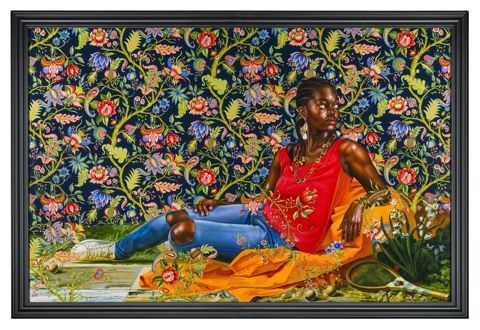“Kehinde Wiley: An Archaeology of Silence” Tours to the MFAH in November

Kehinde Wiley, The Death of Hyacinth (Ndey Buri Mboup), 2022, oil on canvas, courtesy of the artist and Galerie Templon. © 2022 Kehinde Wiley
Following its acclaimed U.S. premiere at the Fine Arts Museums of San Francisco, this new, monumental body of work will be on view in Houston beginning November 19.
HOUSTON—October 24, 2023—The Museum of Fine Arts, Houston, will present Kehinde Wiley: An Archaeology of Silence, the artist’s new, monumental body of work created against the backdrop of the COVID-19 pandemic, the murder of George Floyd, and the global rise of the Black Lives Matter movement. The exhibition had its U.S. premiere earlier this year at the Fine Arts Museums of San Francisco and is on view at the MFAH from November 19, 2023, to May 27, 2024.
Expanding upon American artist Kehinde Wiley’s “Down” series from 2008, An Archaeology of Silence meditates on the deaths of young Black people slain all over the world. These 26 works stand as elegies and monuments, underscoring the fraught terms in which Black people are rendered visible, especially when at the hands of systemic violence. Wiley has said, “That is the archaeology I am unearthing: The specter of police violence and state control over the bodies of young Black and Brown people all over the world.”
“Kehinde Wiley’s elegies, at once sublimely beautiful and deeply disturbing, are profoundly moving, even unforgettable. We are very proud to exhibit them at the Museum and participate in this national tour,” commented Gary Tinterow, Director, the Margaret Alkek Williams Chair, the Museum of Fine Arts, Houston.
The artist’s 2008 “Down” series featured a group of large-scale portraits of young Black men inspired by Hans Holbein the Younger’s The Dead Christ in the Tomb (1521–22). For Wiley, Holbein’s painting triggered an ongoing investigation into the iconography of death and sacrifice in Western art, which he traced across religious, mythological, and historical subjects. An Archaeology of Silence reconceptualizes this research into paintings and sculptures that confront the legacies of colonialism through the visual language of the fallen figure. The resulting paintings of Black people struck down, wounded, resting, or dead, all referencing iconic historical paintings of heroes, martyrs, or saints, offer a haunting meditation on the violence against Black and Brown people through the imagery of European art-historical references.
Kehinde Wiley: An Archaeology of Silence contains some of the largest paintings and sculptures Wiley has created to date, as well as some of the smallest. The series uses scale to elevate the people depicted to heroic status, generally absent from the depictions of the recumbent or fallen figure in Western art (including those that Wiley’s works have been based on). It marks an important departure in the artist’s work which, with the notable exception of “Down,” has been primarily concerned with verticality and elevation, projecting Black youth into positions of power and grace by painting them into compositions inspired by canonical Western portraits such as Anthony van Dyck’s Charles I at the Hunt (1636) or Jacques-Louis David’s Napoleon Crossing the Alps (1801), among many others.
Against the backdrop of the COVID-19 pandemic, Wiley had to forgo his usual practice of “street casting”; he instead worked with residents, staff, and friends of Black Rock, a residency program he established in 2019 in Dakar, Senegal, and where he spent most of his time during the international lockdown. With the rise of the Black Lives Matter movement, Wiley saw an opportunity to broaden the conversation beyond national concerns. The figures’ personal markers of Senegalese and West African culture, with regard to hair in particular, serve as a metaphor for the many places where you find systematically oppressed communities of Black and Brown people experiencing the same systemic violence, around the world.
About Kehinde Wiley
Kehinde Wiley (born 1977, Los Angeles) is an American artist best known for his portraits that render people of color in the traditional settings of Old Master paintings. Wiley’s work brings art history face-to-face with contemporary culture, using the visual rhetoric of the heroic, the powerful, the majestic and the sublime to celebrate Black and Brown people the artist has met throughout the world. Working in the mediums of painting, sculpture, and video, Wiley creates portraits that challenge and reorient art-historical narratives, awakening complex issues that many would prefer remain muted.
In 2018, Wiley became the first African American artist to paint an official U.S. Presidential portrait for the Smithsonian National Portrait Gallery. Former President Barack Obama selected Wiley for this honor. In 2019, Wiley founded Black Rock Senegal, a multidisciplinary artist-in-residence program that invites artists from around the world to live and create work in Dakar, Senegal. Wiley is the recipient of the U.S. Department of State’s Medal of Arts, Harvard University’s W.E.B. Du Bois Medal, and France’s distinction of Knight of the Order of Arts and Letters. He holds a BFA from the San Francisco Art Institute, an MFA from Yale University, and honorary doctorates from the Rhode Island School of Design and San Francisco Art Institute. He has held solo exhibitions throughout the United States and internationally, and his works are included in the collections of over 50 public institutions around the world. At the Museum of Fine Arts, Houston, Wiley’s work was recently presented in the exhibitions The Obama Portraits Tour (2022) and Portrait of Courage: Gentileschi, Wiley, and the Story of Judith (2023). He lives and works in Beijing, Dakar, and New York.
Organization
This exhibition was organized by the Fine Arts Museums of San Francisco, in collaboration with the Museum of Fine Arts, Houston.
Major support provided by:![]()
Media Contact
Melanie Fahey, Senior Publicist
mfahey@mfah.org | 713.800.5345
